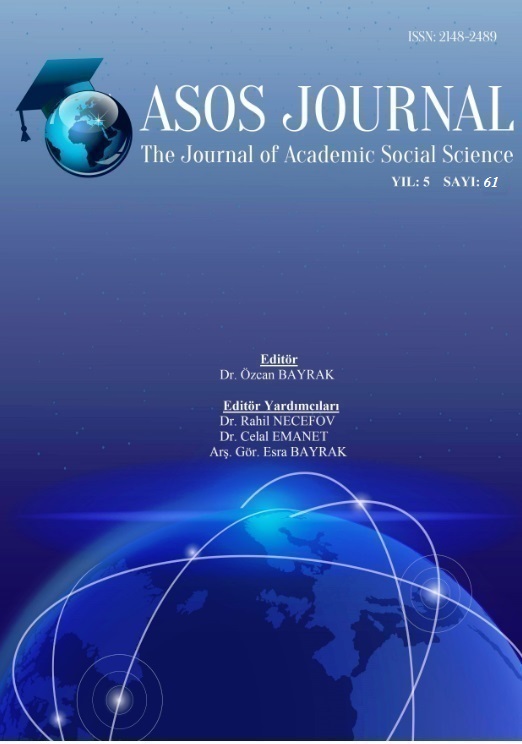Author :
Abstract
Batılı anlamda heykel eğitimi veren ve ülkenin ilk güzel sanatlar okulu, Mekteb-i Sanayi-i Nefise-i Şahane'nin kuruluşu, 1883 yılında, Paris’teki Ecole Nationale des Beaux- Arts model alınarak gerçekleştirilmiş ve neo-klasik bir eğitim anlayışıyla sanat eğitimine başlamıştır. Okul 1923 yılında, Türkiye Cumhuriyeti’nin ilan edilmesiyle, bu dönemde her alanda yapılan yenilikler, modernleşme, çağdaşlaşma, kalkınma ve reform hareketleri sanat alanında da köklü açılımlara yol açmıştır. Yetenekli kişiler devlet tarafından yurtdışına gönderilerek, güzel sanatlar alanlarının gelişimine öncülük etmeleri sağlanmış ve heykel alanındaki eğitim sürecinin güçlenmesi bu dönemlerde başlamıştır. Bu yurt dışına gönderilen sanatçılar, eğitimlerini alarak ülkeye dönmeleriyle, Türk heykel sanatının gelişiminde ve atılım yapmasında önemli yere sahip olmuştur. Dünyaca tanınan heykel sanatçısı Rudolf Belling, bu tarihte Güzel Sanatlar Akademisi’nde, heykel eğitiminin başına getirilmiş, bu sanatçının Akademi’deki etkinliği, Türk heykeli için önemli bir aşama oluşturmuştur. Belling'in, uygulamış olduğu heykel eğitimi programında, modern sanat akım uygulamalarına yer vermemekle birlikte, akademizme de kapılmayan, çağın gelişmelerine açık tavrıyla, türk heykel sanatında yeni bir dönemin kapısını aralamış, kendi uygulamalarıyla da kendinden sonrakiler için örnek oluşturarak, pek çok öğrenci yetiştirmiş, bu yetiştirdiği öğrenciler, ikinci kuşak heykeltıraşlar grubunu; Hüseyin Anka Özkan, Hakkı Atamulu, Yavuz Görey, İlhan Koman, Zerrin Bölükbaşı, Hüseyin Gezer, Turgut Pura, Şadi Çalık oluşturmaktadır Cumhuriyet sonrası, ilk çağdaş Türk heykeltıraşlar ve Türk heykel sanatı tarihinin temellerini atan sanatçılar arasında; Ali Hadi Bara, Zühtü Müridoğlu, Şadi Çalık, İlhan Koman, Kuzgun Acar olduğu görülür. Cumhuriyet’in ikinci kuşak çağdaş sanatçılar arasında ise; Ali Teoman Germaner , Saim Bugay, Tamer Başoğlu, Mehmet Aksoy, Seyhun Topuz , Meriç Hızal , Remzi savaş, Ferit Özşen, Koray Ariş, Osman Dinç, Azade Köker ve Rahmi aksungur gibi isimler yer alır.
Keywords
Abstract
Mekteb-i Sanayi-i Nefise-i Şahane (Academy of Fine Arts), which was the first school of fine arts of the country and which delivered sculpture education in a Western sense, was set up in 1883 by taking Ecole Nationale des Beaux – Arts in Paris as a model, and the school started its art education with a neo-classical understanding of education (Germaner,A.T.199:60-65). After the Turkish Republic was founded in 1923, the innovations and the modernization, development and reform movements were launched in every field in this period, and they lead to radical expansions in the field of art as well. The talented students were sent abroad by the state, and this paved the way for those students to become pioneers in improving the fields of fine arts, and the empowerment of education process in the field of sculpture started in this period as well. When the artists that were sent abroad came back to the country after completing their education, they played a significant role in the development and advancement of the Turkish sculpture art. The world famous sculpture artist Rudolf Belling was assigned as the head of the sculpture education at that time in the Academy of Fine Arts, and the activities of this artist in the Academy constituted an important stage for the Turkish sculpture. While the sculpture education program applied by Belling did not include modern art movement practices, it was not carried away with academism; its open attitude towards the developments of the era cracked the door open towards a new period in the Turkish sculpture art. This program set an example for the subsequent programs with its applications and trained many students. Those students formed the second generation of sculptors that included Hüseyin Anka Özkan, Hakkı Atamulu, Yavuz Görey, İlhan Koman, Zerrin Bölükbaşı, Hüseyin Gezer, Turgut Pura and Şadi Çalık. In the post-republican era, the first modern Turkish sculptors and the artists that laid the foundations of the Turkish sculpture art included Ali Hadi Bara, Zühtü Müridoğlu, Şadi Çalık, İlhan Koman and Kuzgun Acar. The second generation of modern artists of the Republican Era included figures such as Ali Teoman Germaner, Saim Bugay, Tamer Başoğlu, Mehmet Aksoy, Seyhun Topuz, Meriç Hızal, Remzi Savaş, Ferit Özşen, Koray Ariş, Osman Dinç, Azade Köker and Rahmi Aksungur.
